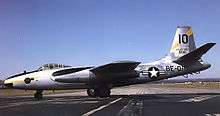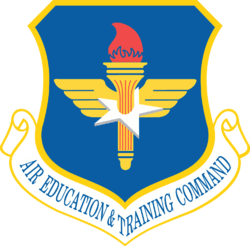86th Flying Training Squadron
| 86th Flying Training Squadron [1] | |
|---|---|
 86th Flying Training Squadron Patch | |
| Active |
15 January 1941 – 2 October 1949 23 March 1954 – 22 June 1962 1 September 1972 – 15 September 1992 1 December 1993 - Present |
| Country | United States |
| Branch | United States Air Force |
| Type | Pilot Training |
| Part of |
Air Education and Training Command 19th Air Force 47th Flying Training Wing 47th Operations Group |
| Garrison/HQ | Laughlin Air Force Base |
| Decorations |
|

The 86th Flying Training Squadron (86 FTS) is part of the 47th Flying Training Wing based at Laughlin Air Force Base, Texas. It operates T-1 Jayhawk aircraft conducting flight training.
History
On 20 November 1940, a new squadron was designated the 86th Bombardment Squadron, Light. Activated on 15 January 1941 and stationed at McChord Field, Washington, its primary mission was anti-submarine patrols utilizing B-18 aircraft. In the six years that followed, the 86th traveled to all parts of the world earning a proud history. The mission was expanded to include training personnel for overseas duty and combat operations.
In 1942, the 86th started its journey through various parts of Europe and North Africa. It was stationed in approximately 20 different locations including French-Morocco (1942), Conrobert, Algeria, (1943) and Salon, France (1944). During that time, the 86th supported combat operations with the DB-7, A-20 and A-26 aircraft. The 86th Bombardment Squadron received numerous campaign streamers and the Distinguished Unit Citation in 1943 and again in 1945. It went on to fly combat missions in the Mediterranean Theater of Operations from, 14 December 1942 – 30 April 1945. During the course of the war the squadron earned two Distinguished Unit Citations.[2]
In 1945, the 86th returned to the United States to begin training in support of a new mission of night tactical operations. Stationed at Briggs Fields, Texas, in 1946, and then Barksdale AFB, Louisiana, in 1948, the 86th was redesigned the 86th Bombardment Squadron, Light, Jet, flying the A-26 and then B-45 aircraft. With the slowdown of military operations, the 86th was inactivated in 1949.
On 23 March 1954, the 86th Bombardment Squadron, Light, jet was reactivated. It was stationed at Sculthorpe RAF Station and Alconbury RAF station, England, flying the B-45 and B-66 aircraft. On 1 Oct 1955, the 86th was redesigned as the 86th Bombardment Squadron, Tactical. The 86th remained in England, maintaining proficiency in a variety of tactical operations and was awarded the Air Force Unit Citation for operations from July 1958 to June 1960. On 22 June 1962, the 86th distinguished itself by acquiring eleven campaign streamers and three Distinguished Unit Citations.
Through the early years of the Cold War the 86th transitioned to the B-45 Tornado and later the B-66 Destroyer aircraft and served as a bomber unit, primarily stationed in England.[2]
On 22 March 1972, the 86th was redesignated the 86th Flying Training Squadron (FTS). The former 3646th Pilot Training Squadron at Laughlin Air Force Base was discontinued and its personnel and equipment transferred to the 86th FTS, and the squadron continued to train undergraduate student pilots in the Northrop T-38 Talon. From 1976 to 1979, the squadron also trained Strategic Air Command Co-pilots in the ACE program. The squadron was inactivated in September 1992. During its twenty years as a pilot training squadron, the 86th Flying Training Squadron earned five Air Force Outstanding Unit Awards.
On 17 February 1994, the 86th Flying Training Squadron was reactivated. The training mission continues utilizing the T-1A Jay Hawk for Specialized Undergraduate Pilot Training. Today the squadron flies the T-1 Jayhawk conducting the specialized undergraduate pilot training phase for airlift-tanker-bomber track pilots.[2]
Operations[3]
Antisubmarine patrols, 9 Dec 1941 – 15 Jan 1942. Combat in Mediterranean Theater of Operations (MTO), 14 Dec 1942 – 30 Apr 1945. Undergraduate pilot training, Sep 1972-Sep 1992 and specialized undergraduate pilot training, 1993 to present.
Lineage[1]
- 86th Bombardment Squadron (Light) (1940–1943)
- 86th Bombardment Squadron, Light (1943–1946)
- 86th Bombardment Squadron, Light (Night Attack) (1946–1948)
- 86th Bombardment Squadron, Light, Jet (1948–1954)
- 86th Bombardment Squadron, Light (1954–1955)
- 86th Bombardment Squadron, Tactical (1955–1972)
- 86th Flying Training Squadron (1972 – present)
Assignments[3]
47 Bombardment Group, 15 Jan 1941 – 2 Oct 1949. 47 Bombardment Group, 23 Mar 1954 (attached to 47 Bombardment Wing, 23 Mar 1954 – 7 Feb 1955); 47 Bombardment Wing, 8 Feb 1955 – 22 Jun 1962. 47 Flying Training Wing, 1 Sep 1972; 47 Operations Group, 15 Dec 1991 – 15 Sep 1992. 47 Operations Group, 1 Dec 1993 – present.
Stations[3]
- World War II
- McChord Field, WA, 15 Jan 1941
- Fresno, CA, 11 Aug 1941
- Will Rogers Field (now Will Rogers World Airport), OK, 15 Feb 1942
- Greensboro, NC (now Piedmont Triad International Airport), 16 Jul-17 Oct 1942
- Médiouna Airfield, French Morocco, 17 Nov 1942
- Youks-les-Bains Airfield, French Algeria, Dec 1942
- Canrobert Airfield, French Algeria, 21 Feb 1943
- Thelepte, Tunisia, 30 Mar 1943
- Souk-el-Arba, Tunisia, 16 Apr 1943
- Soliman, Tunisia, c. 1 Jun 1943
- Ta Kali Airdrome, Malta, 22 Jul 1943
- Torrente Comunelli, Sicily, 13 Aug 1943
- Gerbini, Sicily, 19 Aug 1943
- Grottaglie, Italy, 27 Sep 1943
- Vincenzo Airfield, Italy, 12 Oct 1943
- Vesuvius Airfield, Italy, 13 Jan 1944
- Capodichino, Italy, 22 Mar 1944
- Vesuvius Airfield, Italy, 25 Apr 1944
- Ponte Galeria, Italy, 9 Jun 1944
- Ombrone Airfield, Italy, 23 Jun 1944
- Poretta, Corsica, 12 Jul 1944
- Salon, France, 5 Sep 1944;
- Follonica Airfield, Italy, 19 Sep 1944
- Rosignano Airfield, Italy, 4 Oct 1944
- Grosseto, Italy, 2 Jan 1945
- Pisa, Italy, 15-23 Jun 1945
- Seymour Johnson Field, NC, 14 Jul 1945
- Post-WWII
- Lake Charles AAFld, LA, 9 Sep 1945
- Biggs Field (later, AFB), TX, 20 Oct 1946
- Barksdale AFB, LA, 19 Nov 1948 – 2 Oct 1949
- Sculthorpe RAF Station, England, 23 Mar 1954
- Alconbury RAF Station (later RAF Alconbury), England, 15 Sep 1955
- RAF Sculthorpe, England, 5 Aug 1959 – 22 Jun 1962.
- Laughlin AFB, TX, 1 Sep 1972 – 15 Sep 1992
- Laughlin AFB, TX, 1 Dec 1993 – present
Commanders[3]
|
|
Aircraft[3]
B-18, 1941-1942; DB-7, 1942; A-20, 1942-1945; A-26 (later, B-26), 1945-1949; B-45, 1949. B-45, 1954-1958; B-66, 1958-1962. T-38, 1972-1992. T-1, 1993 – present.
Operations[3]
Antisubmarine patrols, 9 Dec 1941 – 15 Jan 1942. Combat in Mediterranean Theater of Operations (MTO), 14 Dec 1942 – 30 Apr 1945. Undergraduate pilot training, Sep 1972-Sep 1992 and specialized undergraduate pilot training, 1993 to present.
Service Streamers[3]
None.
Campaign Streamers[3]
World War II: Antisubmarine, American Theater; Algeria-French Morocco; Tunisia; Sicily; Naples-Foggia; Anzio; Rome-Arno; Southern France; North Apennines; Po Valley; Air Combat, EAME Theater.
Armed Forces Expeditionary Streamers[3]
None.
Decorations[3]
Distinguished Unit Citations: North Africa, 22 Feb 1943; Po Valley, 21-24 Apr 1945. Air Force Outstanding Unit Awards: 1 Jul 1958 – 30 Jun 1960; 1 Jan-31 Dec 1973; 1 Jan 1976 – 28 Feb 1977; 1 Jan 1979-30 Apr 1980; 1 May 1982 – 29 Feb 1984; 1 Mar 1985-28 Feb 1987; [1 Mar] 1987-31 Mar 1988; 16 Mar 1989 – 15 Mar 1991; 1 Jul 1991-[15 Sep 1992]; [1 Dec 1993]-30 Jun 1995; 1 Jul 1997 – 30 Jun 1999; 1 Sep 2003-30 Jun 2005; 1 Jul 2005 – 30 Jun 2007.
Emblem[3]
Approved on 8 Mar 1945; modified and reinstated on 22 Mar 1995; replaced emblem approved on 20 Feb 1973.
Assignments[1]
- 47th Bombardment Group (1941–1949)
- 47th Bombardment Wing (1951–1962)
- 47th Flying Training Wing (1972–1992, 1993 – present)
Stations[1]
|
|
Aircraft Operated[1]
- B-18 Bolo (1941–1942)
- DB-7 Boston (1942)
- A-20 Havoc (1942–1945)
- A-26 Invader (later, B-26) (1945–1949)
- B-45 Tornado (1949, 1954–1958)
- B-66 Destroyer (1958–1962)
- T-38 Talon (1972–1992)
- T-1 Jayhawk (1993 – present)
References
Notes
Bibliography
External links
- USAF 86th Flying Training Squadron History
- 86th Flying Training Squadron Fact Sheet
- 86th Flying Training Squadron AETC AFHRA Fact Sheet
- 86th Flying Training Squadron Official Facebook Page

